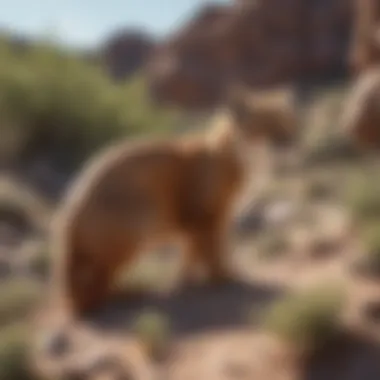Understanding BLM Sites: Management and Challenges


Overview of the Topic
Introduction to the Key Natural Resource Issue
The Bureau of Land Management (BLM) oversees vast areas of public land in the United States, playing a critical role in the stewardship of these unique ecosystems. These sites not only support a wide range of flora and fauna but also serve as important cultural and historical resources. Understanding their significance is essential for anyone concerned about environmental sustainability and resource management.
Background Information on the Significance of the Topic
BLM sites cover about 245 million acres of public land, providing habitats for wildlife, recreational opportunities for the public, and resources that support local economies. However, with the rising pressures from urban development, climate change, and unsustainable practices, the importance of effective management strategies cannot be overstated. Through responsible stewardship, these landscapes can continue to offer benefits and preserve natural heritage for future generations.
Current Status and Challenges
Examination of the Current State
Presently, many BLM sites face serious threats including habitat loss and degradation, invasive species infiltration, and increased demand for recreational use. Unfortunately, resource extraction practices often clash with conservation efforts, leading to conflicts that endanger both ecological integrity and community interests. The state of these resources is in flux, further complicating the BLM's mission.
Identification of Challenges and Threats
- Climate Change: Fluctuating weather patterns contribute to unpredictable water availability and disrupt the delicate balance of local ecosystems.
- Biodiversity Loss: The introduction of invasive species poses a direct threat to the native flora and fauna, leading to further decline in biodiversity.
- Resource Extraction: Mining, grazing, and drilling activities often result in land and water contamination, creating adverse effects on both wildlife and human health.
- Community Engagement: There is often a disconnect between BLM policies and local communities, which can lead to resistance to proposed management plans.
Sustainable Solutions
Exploration of Sustainable Practices
To navigate these challenges, innovative management strategies are necessary. This involves integrating ecological science with community engagement and sustainable resource use.
Showcase of Successful Case Studies
One example worth noting is the partnership between the BLM and local ranchers in the form of the Grazing Improvement Program. By practicing adaptive grazing methods, ranchers have reported better soil health and enhanced biodiversity.
Additionally, the restoration of native plant communities in areas affected by invasive species has shown promising results, underscoring the potential for effective ecological management.
Impact and Importance
Analysis of the Impact
The repercussions of BLM site management ripple through ecosystems. Not only do healthy BLM lands support diverse wildlife, but they also provide clean air and water, which benefits nearby communities. Effective management can lead to reduced flooding, better recreational experiences, and more resilient landscapes.
Emphasis on Conservation Efforts
If humanity stands a chance at reversing the tide of environmental degradation, a focus on conservation and sustainable resource use is indispensable. Everyone has a stake in these lands, from local communities to global citizens concerned about biodiversity loss. Investing in the preservation of BLM sites means ensuring that future generations can also enjoy and benefit from these natural treasures.
"The beauty of the land is more than just its appearance; it is about the life it sustains and the stories it tells."
Understanding BLM Sites
Understanding Bureau of Land Management (BLM) sites is crucial for anyone involved in environmental stewardship or simply interested in the management of natural resources. These lands comprise a significant portion of the United States and play a vital role in supporting ecosystems, wildlife habitats, and recreational opportunities. Grasping the importance of these areas can inform sustainable practices that benefit both human communities and the natural world.
BLM sites are not just patches of wilderness; they are integral to our environmental health and resilience. By managing these lands, the Bureau works to balance conservation efforts with resource extraction, ensuring that future generations inherit sustainable environments.
Definition of BLM Sites
Bureau of Land Management sites refer to the lands administered by the Bureau itself, covering around 247 million acres across the United States. These areas include mountains, forests, grasslands, deserts, and even some lakes and rivers, spanning numerous landscapes. The BLM is tasked with managing these lands for multiple uses, which include recreation, conservation, livestock grazing, mining, and energy development. Every BLM site holds a unique story and contributes to the larger narrative of how land management policies affect the environment.
History of the Bureau of Land Management
The Bureau of Land Management was established in 1946, but its roots go back further to the 1800s, when the U.S. government started managing public lands through various acts. Originally formed from the merging of the General Land Office and the U.S. Grazing Service, the BLM’s mission has evolved over decades. Initially fixated on attracting settlers and promoting land development, its focus has shifted to robust resource management and stewardship of public lands.
Understanding the history of the BLM is paramount for grasping contemporary land management strategies. The evolution from a prioritization of land use to a more balanced approach speaks volumes about shifts in public perception regarding conservation and sustainability.
Geographic Distribution of BLM Lands
BLM lands are not randomly dispersed; they occupy diverse geographical locations primarily in the western United States. States like Nevada, Utah, and Arizona contain the largest tracts of BLM land, while areas in the Midwest and other regions showcase smaller parcels. This geographic distribution underscores the BLM’s commitment to managing areas that hold ecological, cultural, and historical significance.
- Western States: Nevada has the highest percentage of BLM lands, with over 80% of the state’s land managed by the bureau.
- Cultural Significance: Many BLM sites host archaeological sites and historical landmarks that illuminate the nation’s past.
- Recreation: The wide-open spaces allow for diverse recreational activities, from hiking and camping to rock climbing and wildlife watching.


"The stewardship of BLM lands is not merely about protecting resources but also about honoring the legacy they carry for future generations."
With that insight into BLM sites, it’s clear they are not only crucial for resource management but also for fostering a sense of community among those who cherish the outdoors. Knowledge about these lands is the first step in advocating for their responsible management and conservation.
Ecological Significance
Understanding the ecological significance of Bureau of Land Management (BLM) sites is like peeling an onion; there are layers to it, each contributing something vital. These lands don’t just sit pretty; they serve as crucial hubs of biodiversity and ecosystems that sustain various life forms and contribute to the overall health of our planet. As stewards of approximately 245 million acres, BLM plays a pivotal role in preserving natural habitats, mitigating climate change effects, and providing priceless ecosystem services.
Habitat Diversity
BLM sites encompass a broad spectrum of habitats ranging from deserts to forests, wetlands to grasslands. This variety means they are home to numerous plant and animal species, many of which have adapted uniquely to their specific environments. For instance, consider the Great Basin Desert in Nevada, which hosts endemic species like the sagebrush lizard, while areas in the Pacific Northwest shelter endangered species such as the northern spotted owl.
Diversity in habitat types supports a wide range of ecological interactions, making these areas not just beautiful but also vital for ecological resilience. Each habitat serves as a foundation for local biodiversity, offering breeding grounds, foraging opportunities, and spaces for migration.
- The Bay-Delta region in California shows how BLM locations can provide critical aquatic habitats, impacting the life cycles of species such as salmon and delta smelt.
- In contrast, the desert tortoise in the Mojave Desert relies on sun-scorched scrublands that might seem desolate but are brimming with life when examined closely.
This intrinsic diversity also results in a landscape that can withstand environmental shifts better than homogenous ecosystems, thus preserving the overall health of our environment.
Role in Biodiversity Conservation
The conservation of biodiversity is paramount in today’s changing world, and BLM sites are key players in this narrative. By managing diverse ecosystems and protecting key habitats, the Bureau facilitates the preservation of endemic species and promotes sustainable practices that benefit not just wildlife but people too.
A specific example can be seen in the bison populations of the Badlands National Park area, where BLM efforts have led to the recovery of these majestic creatures, allowing them to roam freely across expansive grasslands. Their presence contributes not only to ecological balance but also represents cultural significance to Indigenous peoples.
BLM’s conservation tactics include:
- Wildlife Protection Plans: Designed to safeguard endangered species and critical habitats.
- Partnerships with NGOs: Collaborations with groups that focus on habitat restoration and research; these efforts amplify the impact BLM can have in biodiversity maintenance.
Such measures remind us that these lands are not just geographical locations but lifelines for various species fighting to survive amidst increasing habitat loss.
Ecosystem Services Provided by BLM Lands
Ecosystem services are the free benefits that nature provides, and they play an invaluable role in supporting life. BLM lands are not just picturesque; they offer an array of ecosystem services that are essential for human survival. Some noteworthy services include:
- Water Regulation: Many BLM sites protect watersheds, ensuring clean water supply for millions. The cleansing action of wetlands not only filters pollutants but also ensures aquifers are recharged.
- Carbon Sequestration: Vegetated areas effectively store carbon, helping to mitigate climate change. Forests and grasslands managed by BLM can serve as significant carbon sinks, absorbing CO2 from the atmosphere.
- Recreational Opportunities: Parks and recreational areas provide spaces for outdoor activities like hiking, fishing, and wildlife watching. These activities not only enhance well-being but also foster a connection between people and nature, promoting a culture of conservation.
"Nature does not hurry, yet everything is accomplished." This phrase outlines how BLM lands, through various natural processes and conserved habitats, contribute to a balanced ecosystem that benefits both nature and humanity.
The benefits offered by BLM landscapes are vast. They are complex systems that intertwine with our daily lives far more than many realize. Recognizing the importance of these lands and their management is critical for sustainable futures, making it clear that ecologically significant areas must be regarded as such and treated with the respect they deserve.
Management Practices
The management of Bureau of Land Management (BLM) sites is essential for balancing environmental preservation with sustainable use of resources. Proper management practices not only protect the ecological integrity of these areas but also ensure that they can be enjoyed by future generations. Effective management is a complex undertaking requiring careful planning, stakeholder engagement, and ongoing assessment of the land's health and resilience.
Land Use Planning
Land use planning is a foundational aspect of managing BLM sites. It involves mapping out strategies that dictate how different parts of the land can be used, considering factors like ecological sensitivity, recreational opportunities, and resource extraction. Through comprehensive planning, BLM aims to limit adverse impacts while maximizing the benefits of land use.
Effective land use plans often include:


- Zonation: Dividing areas into zones for specific activities. For example, some regions may be designated for heavy recreational use, while others are set aside for conservation or sensitive wildlife habitats.
- Stakeholder Consultation: Engaging with local communities, stakeholders, and experts. This dialogue helps BLM to gauge public sentiment and gather valuable insights that can inform planning decisions.
- Adaptive Management: Incorporating flexibility to adjust plans based on outcomes and new scientific understanding. This means that if certain areas are found to be more ecologically fragile than initially assessed, modifications can be made promptly to mitigate risks.
Recreational Management
Recreational management refers to the policies and practices aimed at facilitating responsible use of BLM lands for recreation while safeguarding natural resources. From hiking and camping to off-road vehicle use, BLM lands offer a plethora of outdoor activities. However, with great opportunities come responsibilities.
The importance of recreational management manifest in several ways:
- Maintaining Trails and Facilities: Regular upkeep of trails, campsites, and facilities ensures safety and enhances user experience. You wouldn't want to stumble over a broken bridge while taking in the beauty of nature—it's about keeping the outdoors welcoming.
- Education Programs: Offering workshops, signage, and materials that teach visitors about Leave No Trace principles can bolster eco-conscious behavior. These initiatives can ensure everyone plays their part in protecting the environment.
- Permit Systems: Implementing permits for certain activities, like hunting or camping in sensitive areas, can help manage the number of users and reduce pressure on vulnerable ecosystems.
Sustainable Resource Extraction
Sustainable resource extraction involves the careful and responsible harvesting of natural resources from BLM sites while preserving the ecological balance. This includes practices such as mining, logging, and oil drilling, all of which can have significant effects on the environment.
Key principles to achieving sustainable resource extraction include:
- Environmental Assessments: Conducting thorough studies before any extraction activity is crucial. Understanding the potential impacts helps to make informed decisions that promote ecological health.
- Best Management Practices (BMPs): Utilizing BMPs ensures extraction activities are as less disruptive as possible. For instance, using techniques that minimize soil erosion or keeping machinery away from sensitive areas can make a world of difference.
- Restoration Efforts: After resources are extracted, efforts should be made to restore the land to its natural state. This may include replanting native species or contouring landforms to promote natural processes.
It’s not just about taking from nature; it's about understanding how to give back to it after taking.
In summary, the management practices surrounding BLM sites are crucial for negotiating the often delicate balance between human enjoyment and environmental health. From thoughtful land use planning to recreational oversight and sustainable extraction methods, each facet contributes to a broader goal of responsible stewardship in these invaluable landscapes.
Challenges in Management
The management of Bureau of Land Management (BLM) sites is riddled with complexities that extend beyond simple land use decisions. Addressing these challenges is essential for the sustainability of these vital landscapes, where balancing ecological integrity with human needs becomes an intricate dance. Each challenge has the potential to significantly impact not only the environments themselves but also the communities that rely on these lands for their livelihoods and recreational activities.
Climate Change Impacts
Climate change poses a significant threat to BLM sites, impacting ecosystems in irreversible ways. Rising temperatures can lead to altered precipitation patterns, which in turn affect the delicate balance of flora and fauna. For instance, think about how certain plant species depend on specific humidity levels and temperature ranges. When these parameters shift, some plants may flourish, while others face decline. This kind of environmental flux disrupts established habitats.
Furthermore, extreme weather events such as wildfires, droughts, and floods have become increasingly frequent. These phenomena not only threaten wildlife but also jeopardize recreational access and the overall health of the landscape. As such, management strategies must evolve continuously to adapt to these changing conditions. Effective monitoring systems and climate adaptation strategies are necessary to mitigate these impacts. This includes re-forestation initiatives and improved water conservation practices that can help buffer against harsh climate effects while preserving biodiversity.
Invasive Species Issues
Invasive species represent another daunting challenge for the management of BLM lands. These are plant or animal species introduced to an area where they previously did not exist, often outcompeting native species for resources like sunlight, water, and nutrients. This can lead to a decline in biodiversity, affecting ecological health and resilience.
Take, for example, cheatgrass. This invasive plant rapidly spreads across many BLM sites, changing fire regimes and altering soil composition. Dealing with invasives requires concerted efforts, including public education about the impacts of releasing non-native species into the wild and targeted removal programs. Habitat restoration becomes crucial here; we must actively replace invasive species with native plants to restore the natural ecological balance.
Balancing Conservation and Resource Use
One of the critical balancing acts in BLM site management is finding a middle ground between conservation goals and resource extraction, such as mining and timber harvests. On one hand, the extraction of resources can provide jobs and stimulate local economies. On the other hand, it can lead to irreversible environmental degradation and habitat loss.
To address this, integrated resource management plans are vital. These plans must consider both ecological health and the social needs of surrounding communities. Techniques such as adaptive management allow for ongoing assessment and adjustments to plans based on real-time environmental data and community feedback.
In essence, managers face a challenging dilemma: how do they safeguard the natural world while also promoting responsible use? The answer lies in transparency and collaboration among stakeholders, ensuring that every decision aligns with broader ecological and social interests.
"The future of our BLM sites hinges on our ability to navigate these challenges with foresight and responsibility."
Through understanding and addressing these challenges, we pave the way for future generations, ensuring that BLM lands remain healthy and vibrant, equipped to withstand the test of time.


Community Engagement
Community engagement represents a cornerstone in the effective management of Bureau of Land Management (BLM) sites. The active involvement of communities in decision-making processes lays the foundation for more sustainable practices. When local populations contribute to the management of these lands, it creates a shared sense of responsibility that is indispensable for ecological stewardship. Here, we delve into several critical aspects of community engagement that highlight its significance.
Public Involvement in Decision Making
Public participation in decision-making arms locals with a voice. When members of the community are invited to share their thoughts and concerns regarding land management strategies, it fosters transparency and trust. Citizens tend to have profound knowledge of their environment and challenges specific to their regions. Through public workshops, surveys, or consultations, decision-makers can harness this invaluable grassroots insight. This input is not merely advisory; it becomes a critical element in shaping sustainable practices.
Additionally, when people have a role in decision-making, they are more likely to support and adhere to management practices. They feel invested in the outcomes, thus ensuring better compliance and advocacy for both local and broader environmental goals. A notable example is the BLM's open forums in states like Colorado, where community input has significantly influenced land use plans.
Volunteer Programs
Volunteer initiatives create an engaging platform for community members to participate actively in the care and maintenance of BLM land. Programs ranging from trail cleaning to habitat restoration make participation not just simple, but rewarding too. People often find fulfillment in giving back to nature, and such endeavors often yield stronger community bonds.
Empowering locals to contribute directly can lead to successful stewardship of BLM areas. These volunteers become ambassadors for conservation, spreading awareness and knowledge within their circles. For instance, many areas have seen a resurgence in native plant populations thanks to volunteer-led planting events, illustrating the potential for collective action to yield significant ecological benefits.
Education and Awareness Campaigns
Education serves as a bridge between the community and the complexities of land management. Awareness campaigns designed to enlighten residents about the importance of the ecological benefits of BLM sites can result in increased respect and protection for these areas. Workshops, school programs, and outreach efforts are pivotal in crafting informed citizens who understand the challenges these lands face.
Moreover, engaging educational initiatives can turn passive observers into active participants. People often respond positively to learning opportunities that foster a deeper understanding of environmental issues. By collaborating with local schools and organizations, the BLM can encourage youth to step into conservation roles, nurturing the next generation of environmental stewards.
The strength of community engagement lies in its ability to transform passive observers into active participants, creating a more sustainable future for BLM sites.
In essence, community engagement is not merely an obligation but an enriching element of managing BLM lands. By embracing public involvement, nurturing volunteer opportunities, and promoting education, the BLM cultivates a community that understands and values their environment. Each of these elements reinforces a collective commitment to responsible stewardship, ensuring that these critical landscapes endure for generations to come.
Future Directions
In the complicated landscape of land management, the future directions for Bureau of Land Management sites are of critical importance. As we look to confront mounting ecological challenges, it's essential to be proactive and strategic about how these lands are nurtured and utilized. Through innovative management strategies, robust partnerships with conservation organizations, and a rigorous approach to monitoring and evaluation, we can ensure that BLM sites not only survive but thrive in the shifting ecological context.
Innovative Management Strategies
Innovative management strategies become paramount in addressing the many issues facing BLM lands today. These strategies dive beyond the traditional one-size-fits-all approaches and embrace adaptive management that is tailored to specific local conditions.
- Integration of Technology: Using GIS (Geographic Information Systems) and remote sensing tools can vastly improve land management practices, allowing for better tracking of environmental changes and land use.
- Community-Based Approaches: Engaging local communities in decision-making processes hinges on recognizing their knowledge and stake in the land.
- Restoration Projects: Prioritizing restoration projects that aim to bring back native habitats can enhance biodiversity and resilience against climate change impacts.
Applying these strategies is about thinking creatively and collaboratively to meet the challenges posed by our environment.
Partnerships with Conservation Organizations
Forming partnerships with conservation organizations does not only expand the resources available for BLM management, but also enriches the ecological knowledge applied on the ground. Nonprofits, universities, and neighborhood groups often have unique expertise and local insights that can inform more effective management practices.
- Shared Resources: Collaborative efforts can result in pooled funding and shared personnel which amplify the impact of conservation initiatives.
- Conservation Education: Such partnerships frequently facilitate educational programs that raise awareness and involvement among the public.
- Research Initiatives: They can promote innovative research that helps to evaluate ecological outcomes and improve management methods.
Working hand in hand with these organizations can lead to more informed decisions and sustainable practices that honor the intrinsic value of BLM sites.
Monitoring and Evaluation of Ecosystem Health
An ongoing commitment to monitoring and evaluating ecosystem health is essential for the effective management of BLM lands. Continuous assessment not only measures success but also highlights areas needing improvement.
- Developing Baselines: Establishing baseline ecological conditions is vital as it provides a framework against which future changes can be measured.
- Longitudinal Studies: Implementing long-term ecological studies allows for the recognition of trends over time that can inform management actions.
- Adaptive Management Framework: Grounding management in science requires an adaptive framework that is responsive to environmental feedback, ensuring that strategies can be adjusted based on new findings.
As we navigate into the future, the embrace of these monitoring protocols helps tailor approaches to be more efficient and responsive to changes within the ecosystems.
"The strength of the BLM's management will always be rooted in adaptability, collaboration, and a vigorous commitment to the land's ecological integrity."
In this journey, forward-thinking strategies and flexible partnerships will ultimately aid in safeguarding the BLM sites for both current and future generations.



